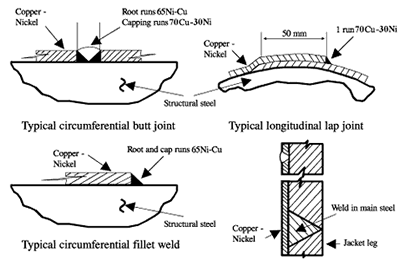by Carol Powell; Consultant to CDA; 2002
The corrosion rate of steel in the splash zone can vary with location and season but rates generally are in the range of 0.5-1.5 mm/yr. The corrosion rate is increased dramatically if the steel surface temperature is elevated as can occur in hot riser pipes. Risers are fluid conduits in the offshore industry that extend from the sea floor well or pipeline to the platform structure at the sea surface. Temperatures can be in excess of 90°C and steel corrosion rates of 8 mm/yr can be experienced. Cathodic protection is not effective in this area and coatings are vulnerable to erosive wave and spray action.
Sheathing offshore in Cu-Ni can be applied either for splash zone corrosion protection and/or to reduce biofouling and therefore wave drag, or minimise cleaning regimes on legs and risers. For straight splash zone corrosion protection, the Cu-Ni is usually welded into position. For biofouling protection, it is supplied as a composite product of half cylinder sheets, perforated sheet, granules or wire bonded onto an insulating backing, e.g. neoprene.
Splash zone sheathing on steel offshore platforms in 90-10 Cu-Ni should at least span from below mean tide level to well into the atmospheric zone. Potential galvanic corrosion on the adjacent steel is addressed by coating the more accessible top section with paint; the bottom, submerged junction will be protected by the cathodic protection system normally applied to the structure.
Welded splash zone sheathing is normally 3-5 mm thick. The sheet is pre-formed to half cylinders and longitudinal joins are lapped so that the alloy is welded to itself. Horizontal butt welds between sections can be made direct to the steel and are often a 3-bead method such that the cap experiences minimum dilution from the steel. Occasionally, where the steel has a rough surface or it is not considered appropriate to weld the alloy sheathing direct to the steel riser or structure, horizontal steel bands are initially welded to the steel and the sheathing welded to the band. An outline of a typical cladding assembly is shown in Figure 1 with an indication of the types of joint involved and the weld procedure.
 Figure 1. Typical joints for splash zone sheathing
Figure 1. Typical joints for splash zone sheathingIn 1984, Cu-Ni was used to cover legs on production and accommodation platforms, three drill platforms and a flare stack in the Morecambe Field, a major gas field in the Irish Sea. The sheathing was welded directly to the steel and spanned +13m to -2m Lowest Astronomical Tide. The sheathing was 4mm thick annealed sheet. The legs were cathodically protected which resulted in fouling of the Cu-Ni. This sheathing has performed well. Unexpectedly, divers have observed that the biofouling mass on the sheathing is reduced to about 30% compared to the adjacent steel in spite of the cathodic protection. The fouling is also loosely adherent and can be easily removed with a light scraping action.
Supporting these findings, 10 year trials at the LaQue Corrosion Services, in Wrightsville Beach, North Carolina, USA, have shown that although biofouling will occur when cathodic protection is applied, some biofouling resistance is retained. The biofouling mass accumulated on bare steel piling is more than twice as great as that on steel sheathed with direct welded 90-10 Cu-Ni whether or not it was cathodically protected, and more than 20 times that attached to insulated Cu-Ni sheathing.
One product, which has been successfully used for splash zone and biofouling protection of structural legs, cross bracings and riser pipes, involves discrete granules of Cu-Ni, 1mm diameter and 1mm long bonded into the surface layer of 3mm thick neoprene sheet. The processing ensures that the granules are distributed and exposed over the surface such that about 30% of the surface is Cu-Ni and each granule is close enough to its neighbour to allow complete surface protection. The product can be hot bonded onto elastomeric corrosion coatings or cold bonded directly onto steel. The track record dates back to 1984 with over 13,000 square metres supplied for several platforms world-wide.
Back to TopReferences
- Alloys of Copper and Nickel for Splash Zone Sheathing of Marine Structures, Michels, Harold T. & Powell, Carol A., , Copper Development Association Inc., .
- Copper-nickel Welding and Fabrication, Published by CDA Inc as A7020-99/13, Nickel Institute as 12014 Second Edition and CDA UK as Publication 139 Second Edition .
- OSNA®-10 Copper-Nickel Sheathing on Offshore Structures, Brochure, KME Germany GmbH & Co. KG , .
- Review of Splash Zone Corrosion and Biofouling of C70600 Sheathed Steel During 20 Years Exposure, Powell, C. and Michels, H., Eurocorr 2006, Maastricht, .
- Standards and Properties, CDA, .
